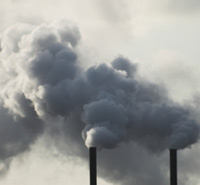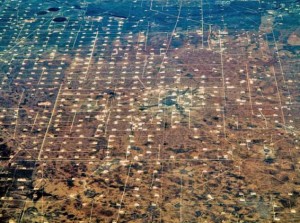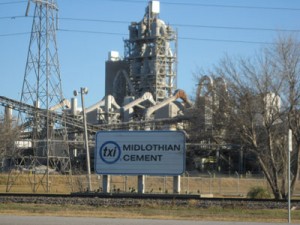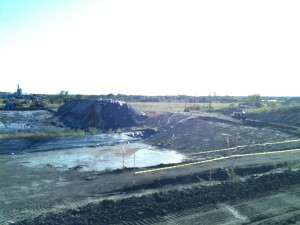Archive for October 2013
World Health Organization: Air Pollution Causes Lung Cancer
 As of Thursday, the air you breathe CAN kill you, at least according to the World Health Organization, which officially classified air pollution as a cause of lung cancer. The move came after the group released a report earlier this year estimating that over 220,000 people died from lung cancer worldwide from exposure to bad air. Most of those deaths are occurring in countries in Asia.
As of Thursday, the air you breathe CAN kill you, at least according to the World Health Organization, which officially classified air pollution as a cause of lung cancer. The move came after the group released a report earlier this year estimating that over 220,000 people died from lung cancer worldwide from exposure to bad air. Most of those deaths are occurring in countries in Asia.
Mostly these deaths are due to Particulate Matter pollution, the ubiquitous tiny particles of soot that are produced when things burn, like gas in cars, coal or gas or waste in power plants and cement kilns, and diesel engines and flares in the the gas fields.
Researchers have been producing one study after another for years linking a variety of illness and diseases to various ingredients of dirty air and specifically, Particulate Matter. Parkinson's Disease and other nerve and brain-related ailments, heart attacks and strokes, and of course respiratory problems have all been blamed on PM, but this is the first time it's been classified as a carcinogen. Most scientists in the field believe that there's really no level of exposure to the pollution that's completely "safe."
PM levels in DFW are generally low, but they've been rising over the last couple of years, and those measured levels are based on all of two monitors for all of the Metromess, so they could mask hot spots downwind of large sources (think Midlothian, compressors, and busy freeways). The EPA has proposed a new federal standard that's much lower than the current one, but it has yet to be implemented.
New Studies Link Air Pollution to Pregnancy Risks
 Two new studies provide more evidence that current air pollution standards are not protective of human health.
Two new studies provide more evidence that current air pollution standards are not protective of human health.
On Monday, the British Medical Journal, The Lancet, published the results of a huge European-based examination of the effects of Particulate Matter pollution (PM) on the birth weight of newborns. It pooled 14 different previous studies that included more than 74.000 mother-child pairings over 12 countries.
Concentrations of PM below the current European Union standard of 25 micrograms per cubic meter of air – twice the new US standard proposed by EPA in 2012 – were linked to low birth weigh babies. The authors estimated that for every 5 micrograms increase in PM, there was a corresponding 18% increase in there risk of giving birth to an underweight child. Most scientists looking at data like this suggest there really is no safe standard for exposure to PM – that is, any amount can be harmful to health in some way. In this case, the PM was going from mother to child and affecting its health even before coming out of the womb and taking its own first breath.
“We have evidence from animal studies that the tiniest particles enter the bloodstream and go to the fetus,” said the senior author, Rémy Slama, a senior investigator at the Institute of Health and Medical Research in Grenoble, France. “Can we expect other health effects in these children? There are hints that there might be — low birth weight is a marker of negative effects in adulthood.”
PM Pollution comes primarily from types of combustion, like flares in the gas field, power plants, cement kilns and yes, your internal combustion engine in you car. PM pollution is dense along heavily-traveled roads and highways. This kind of information is slowly beginning to impact urban planning. You probably don't want to put an elementary school next to a freeway, or an apartment complex at an intersection. Likewise, you want to try to avoid living directly downwind of thick plumes of the stuff coming from, say an industrial complex that hosts three cement plants and a steel mill. i.e Midlothian.
A University of Florida study that came out last week concluded that pregnant women who live in areas with high levels of air pollution were more likely to suffer from high blood pressure. In this case, the health of approximately 22,000 pregnant women were correlated to readings from local air monitors. Those women living closer to monitors registering high levels of air pollution – defined as not only PM, but smog-forming Nitrogen Oxide and Volatile Organic Compounds – were 12 to 24 % more likely to also have high blood pressure. Although flawed in some important ways by not ruling out variables like weight, the report falls in line with previous studies linking air pollution to blood pressure spikes.
Join The Morning News’ Call to “Dig It Up, Haul It Off, Make It Safe” Tonight at Frisco City Hall
October 14th, 2013
We wouldn't blame Frisco officials for offering a hearty "we told you so" after the state's top environmental regulator said bankrupt Exide Technologies needs to do more to clean up contaminants from its shuttered battery recycling plant.
Given the Texas Commission on Environmental Quality's sometimes spotty enforcement reputation, this newspaper is pleased to see TCEQ's aggressive investigation into Exide and the resulting list of citations. In a 10-point notice of enforcement, TCEQ says waste buried in Exide's landfill in Frisco contains dangerous levels of lead dating to 1998. TCEQ also says Exide failed to adequately test for cadmium, a known carcinogen, before waste was hauled off to a regional recycling facility in 2012 and 2013.
Given Dallas' bad experiences with similar remediation and redevelopment challenges in West Dallas and many parts of southern Dallas, we urge Frisco to continue to press Exide for as complete a cleanup as possible. As West Dallas knows all too well, years after a dirty lead smelter closed there, its legacy has hindered development.
Exide says it will work with Frisco and environmental regulators in remediating the plant property, but its bankruptcy filing this spring and disputes over dangerous materials found downstream have complicated the cleanup process.
That's all the more reason Frisco should view this enforcement notice from TCEQ as an affirmation of what city officials have believed to be true about contamination around the plant site. The state agency and the federal Environmental Protection Agency also urged Exide to revise its groundwater assessment plan, which would require a more stringent and expensive cleanup plan.
Exide and Frisco struck a landmark deal more than a year ago to shutter the battery recycler, a major step toward the city reclaiming industrial land for a cleaner environment and recreational purposes. Now Frisco should take the additional step of asking the bankruptcy court judge to require Exide to put aside funds to cover the more extensive cleanup.
A comprehensive approach to reclaiming the land would end questions about contamination and potential risks to Stewart Creek and the proposed Grand Park in Frisco. With Exide in bankruptcy, none of this will be a simple matter. It is, however, the right thing to do for the environment and the community.
TONIGHT:
Frisco City Council Meeting
7pm -7:30 pm
City Council Chambers
Frisco City Hall
Please Spend 2 Minutes
Speaking-Up for Frisco's Future During
Citizens Comment Time Tonight.
Thanks
As All (Regulatory) Hell Breaks Loose in Frisco, Council Must Decide Between “Kia and Cadillac” Clean-ups
 For over a year now, Downwinders and Frisco Unleaded members have been urging the City Council and regulators to treat Exide's on-site "non-hazardous waste" landfill as a hazardous waste dump. Our characterization was based on the evidence already in the files, combined with Exide's own track record. But a new round of discoveries validates our conclusion.
For over a year now, Downwinders and Frisco Unleaded members have been urging the City Council and regulators to treat Exide's on-site "non-hazardous waste" landfill as a hazardous waste dump. Our characterization was based on the evidence already in the files, combined with Exide's own track record. But a new round of discoveries validates our conclusion.
On September 28th, the Texas Commission on Environmental Quality issued 10 violations concerning Exide's disposal and treatment of hazardous waste.
Those violations include samples taken from the closed parts of the "non-hazardous waste" landfill that turn out to be extremely hazardous. The particular cells sampled contain waste from operations as far back as 1998. That means we're looking at thousands of tons of illegally-disposed hazardous waste where there wasn't supposed to be any at all.
Exide has been arguing that any discrepancies between the toxic contents of their landfill and its "non-hazardous waste" designation was a recent problem because of a bad treatment recipe. Turns out, not so much.
In fact, after taking samples from the still-open parts of the landfill back in Spring, the state found they too violated toxicity standards. Reportedly, the TCEQ engineers have been trying to recreate Exide's "treatment process" without any success. Looking back over all the (post-closure) test results, the truth is that that "treatment process" probably never worked in the first place.
The September 28th violations also include open piles of lead slag waste on the edge of the landfill itself and stacks of 2-ton "superbags" of lead waste slag lying around various parts of the smelter site – all testing at hazardous levels for lead and other toxics, and all completely unauthorized as hazardous waste sites.
Among the most mysterious discoveries is that Exide sent over 3,300 tons of this same lead slag waste to be buried at the huge landfill in Lewisville at the corner of 121 and I-35 in May of 2012.
Exide labeled the waste "non-hazardous" as it went through the landfill's gate, but that label wasn't correct. Exide didn't adequately test the waste for cadmium, despite knowing the waste could easily test positive for the toxin. There is now going to be a whole chapter of the Exide clean-up taking place in Lewisville.
You can read the very dry TCEQ inspection report on the City of Frisco's website here. No word yet on fines or punishment. You can read the Dallas Morning News coverage here.
Now that it's official that Frisco has a hazardous waste dump, the City Council must decide by December 9th if it wants to keep that dump permanently, or dig up and haul off its toxic contents. That's the day the city must put in its monetary claim to the judge overseeing the Exide bankruptcy case.
This summer the city hired a consultant that gave it two options for dealing with the Exide site in case the company could not pay for the clean-up, which now appears likely.
The city could ask for $25 million to be set-aside for a 40-acre permanent toxic waste dump surrounded by a mile long "slurry wall" to keep the content from leaking out into Stewart Creek and Grand Park. Tha's the "Kia" option.
Or it could ask for $135 million to be set aside for a clean-up that would dig up all the waste, haul it off to a licensed hazardous waste landfill, and leave the property fit for commercial development and green space. That's the "Cadillac" option.
Even though it's probable that Exide won't have the money itself to finsih the clean-up, it's important for the Council to publicly take a stand for the complete "Cadillac" clean-up of Exide. A landfill would pose a permanent risk to both Stewart Creek abd Grand Park. Financing the plan without using Exide money will be a challenge, but then so was buying the company out and closing it down, and putting together the package that recently brought the Cowboys training facility to Frisco.
You can click here at our Citizen Action of the Week page to send a read-to-go e-mail to the Frisco City Council requesting they choose the comprehensive "Cadillac" option, You can also add your own comments too.
Besides finding massive violations in and around its Frisco landfill, the Texas Commission on Environmental Quality and EPA have also recently rejected Exide's proposed clean-up of the smelter property.
Among the largest issues was disagreement over the classification of groundwater flowing underneath the Exide site, which straddles two forks of Stewart Creek and sits in the steam's natural valley.
Both the state and EPA are insisting that the flow of Exide groundwater is so high that the entire property should be held to stricter clean-up standards – 100 times better than what Exide was proposing. This is also a standard that Frisco Uneaded and Downwinders has been pushing for.
Other issues in the rejection include the demand by the agencies that the company also address contamination in Stewart Creek, the appearance of mysterious barrels of toxic and long-ago banned PCB's, and more investigation of what kind of fill the entire complex was built on (hint: it might be the same stuff that's also going into the "non-hazarous waste" landfill).
In all there are 34 separate items that the state has given Exide to change, report on, follow-up, or sample. The TCEQ's rejection letter can be accessed and downloaded through the City of Frisco website here.
This is all good news. Frisco Unleaded has been arguing that the entire Exide site should be cleaned-up to levels that would allow residential and green space use.
On the other hand, it might all be academic because of the fact that Exide is in bankruptcy court. We'd have a standard but no money to get the job done.
That's why the decision the council makes on December 9th is so important. It must decide to ask the bankruptcy court for the amount to cover either a permanent toxic waste landfill in downtown Frisco forever, or a clean-up that will leave the site available for prime real estate development. Please send the City Council a message that you don't want them to be cheapskates with public health.
Your Tax Dollars at Work: TCEQ Argues Air IS NOT a Natural Resource
 So this is how ideological things have become at the Texas Commission for Environmental Quality. Even though the agency won a fight in court to keep a group of parents represented by the Texas Environmental Law Center from being able to sue the state for not regulating Greenhouse Gases, TCEQ lawyers are working overtime to make the judge in the case retract this statement:
So this is how ideological things have become at the Texas Commission for Environmental Quality. Even though the agency won a fight in court to keep a group of parents represented by the Texas Environmental Law Center from being able to sue the state for not regulating Greenhouse Gases, TCEQ lawyers are working overtime to make the judge in the case retract this statement:
“The Court will find that the Commission’s conclusion, that the public trust doctrine is exclusively limited to the conservation of water, is legally invalid. The doctrine includes all natural resources of the State."
To the untrained eye, this might seem a pretty innocuous piece of prose. Water, air, land, these are pretty much the very definition of "natural resources." But them are fightin' words to Rick Perry's environmental watchdogs. Concede this point to the hippies, and there's a slippery slope leading all the way down to effective regulation and supervision of airborne threats to the public health. Unacceptable.
You see under state law, only water is legally treated as a natural resource in Texas, subject to what's called the "public trust doctrine," which requires government to protect and maintain certain shared resources fundamental for human existence.
TCEQ lawyers are saying air just isn't so fundamental to humans as the wet stuff, although the last time we checked, most people could only last 2 to 5 minutes without it.
State lawyers late last month argued in front of the Texas Third Court of Appeals that Judge Triana’s comments were beyond the scope of the case and should be vacated.
Terry Clawson, an agency spokesman, said….“The T.C.E.Q. has concerns with how the district court opinion addressed the matter of public trust doctrine,” Mr. Clawson added. “The scope of this doctrine is a very important issue, which deserves to be fully vetted.”
The agency complained to the court that Judge Triana’s statements were seen by the plaintiffs “as a victory,” even noting that environmental groups had called her ruling “a blockbuster” for their cause in news releases.
But David Spence, a professor of business and law at the University of Texas at Austin, said the scope of public trust was more symbolic than practical.
“In a sense it’s a kind of low-stakes argument,” Mr. Spence said. “The public trust doctrine in the U.S. is a fairly weak thing.”
Each state applies the principle differently, and few have used it with much force. The doctrine has generally been successful only at protecting open beaches for public use, Mr. Spence said.
So which is it – practical or symbolic? For both citizens and the TCEQ, the two are one in the same. Rick Perry's appointees cannot afford to let citizens get their foot in the legal door to establish a principle that may result in one day overriding their own authority, however abstract it appears that threat is now.
Likewise, in a state government as hostile to citizen concerns as this one, what do you have to lose in trying to establish a, er, beachhead, in terms of seeing safe and legal air as a finite "natural resource" that should be protected? Indeed, one of TCEQ's predecessor's names was the Texas Natural Resources Conservation Commission. It regulated air pollution in Texas – presumably because it was a Natural Resource. This "Hail Mary!" legal strategy seems at least as effective as going down to Austin every two years expecting things to get better.
The appeals court is expected to rule soon. It could remove the statement entirely from the record the way TCEQ wants, or merely say is a statement and not a legal precedent, which is what even the plaintiff's lawyers expect. Stay tuned.
New National Report: Texas is Source of Over 50% of Total US Fracking Pollution
 While most of the national publicity surrounding fracking over the past couple of years has involved documenting its encroachment into the Midwest and East Coast, a new first-of-its-kind report demonstrates why Texas is still the center of the oil and gas industry's universe.
While most of the national publicity surrounding fracking over the past couple of years has involved documenting its encroachment into the Midwest and East Coast, a new first-of-its-kind report demonstrates why Texas is still the center of the oil and gas industry's universe.
Last week the Environment America Research & Policy Center released "Fracking by the Numbers: Key impacts of Dirty Drilling at the State and National Level." As far as we can tell, it's the first systematic collection of quantifiable state-by-state data on the environmental costs of fracking in the entire US – the amount of water used in drilling operations, the amount of air pollution produced, the amount of acreage devoted to leases, etc.
Of course, the numbers all come from either the annual self-reporting industry performs for state and federal regulators, or those regulators themselves, so there's a good chance they're being under-estimated. Nevertheless, the total numbers are still huge and shocking. And what really catches the eye in the state-by-state breakdowns is just how much the operations around us here in Texas contribute to those huge and shocking numbers. We're not just the Belly of the Beast. We're the belly, upper and lower intestines, bowels, and open-throated mouth of the beast.
Number of Wells:
Of the almost 82,000 wells drilled across the country since 2005 (when the Energy Act with the "Halliburton Loophole" included was passed and signed), fully 34,000 have been drilled in the Lone Star State. The second closest state is Colorado with a little over 18,000.
Think things have slowed down and moved elsewhere? Of the 22,300 wells drilled since 2012, 13,500 of them have been in Texas. Colorado again comes in second with 1,900.
Acres of Land Damaged:
130,000 acres out of a US total of 360,000 acres. Colorado is second with 50,000.
Amount of Water Used
Out of a national total of 250,000,000,000 gallons of water used to frack wells, Texas accounts for 110,000,000,000. Pennsylvania is second at 30,000,000,000 gallons.
Amount of Waste Water Produced
Out of a national reported total of 280,000,000,000 gallons (that's 280 billion) of unusable toxic wastewater that needed to be disposed of permanently in injection wells, Texas accounts for 260,000,000,000 gallons. North Dakota is a distant second with 12,000,000,000.
Air Pollution
None of these figures includes totals from other kinds of facilities in the gas cycle, like compressors or pipelines, or storage tanks – just drilling pad operations.
Particulate Matter
Approximately 8,000 tons in Texas out of nationwide total of 13,000.
Nitrogen Oxide (smog-forming)
100,000 tons in Texas out of 170,000 for the entire US.
Carbon Monoxide
153,000 tons in Texas out of a US total of 250,000 tons.
Volatile Organic Compounds (smog-forming and toxins)
14,000 tons in Texas out of 23,000 nationwide.
Sulfur Dioxide (acid rain, respiratory irritant)
300 tons in Texas out of a total of 600 tons nationwide.
Greenhouse Gases
40,000,000 tons in Texas out of a US total of 100,000,000.
When a single state accounts for more than half of the wells, the waste water, and the entire country's air pollution burden from fracking, you understand why campaigning against the industry's practices in Texas is the political equivalent of fighting behind enemy lines. It makes recent victories like the defeat of the Trinity East permits and the adoption of a tougher draft Dallas gas ordinance all the more remarkable, and important.
Beginning in 2006, many of us were caught off-guard by the invasion of wells that swept eastward into the metropolitan DFW area. We didn't know enough to know what questions to ask, or we didn't want to ask them. Now, living in the largest urban gas play in the US, and inventorying these kinds of mind-numbing statistics, we don't have any excuses. Fracking represents one of the most profound environmental and public health challenges ever to confront DFW or Texas. The most important question now is what we intend to do about it.
TXI Stock Takes a Dive, New North Texas Cement Plant on Way?
 Last Wednesday TXI stock didn't do as well as Wall Street thought it should for the quarter and the result was about a 10% drop in value over one day's trading. On a Thursday conference call, CEO Mel Brekhus defended the company's prospects, including the opening of its new Central Texas plant, saying it "was the most successful of any he had been involved with in his career." We imagine that's right since the only other plant the company has built recently was Kiln #5 in Midlothian which faced opposition from Downwinders and others in the early part of the last decade.
Last Wednesday TXI stock didn't do as well as Wall Street thought it should for the quarter and the result was about a 10% drop in value over one day's trading. On a Thursday conference call, CEO Mel Brekhus defended the company's prospects, including the opening of its new Central Texas plant, saying it "was the most successful of any he had been involved with in his career." We imagine that's right since the only other plant the company has built recently was Kiln #5 in Midlothian which faced opposition from Downwinders and others in the early part of the last decade.
But most intriguing from DFW residents' point of view was the hint that Brekhus casually dropped toward the end of the call that the company was thinking about "increasing capacity" in North Texas. You know what that's code for – a new cement kiln.
Midlothian has been home to the nation's largest concentration of cement manufacturing for a long time, but such an addition would solidify its position for decades to come. That's because these days kilns come in one size – very, very large. A new TXI kiln would be massive in all respects. Air pollution would go up considerably, possibly canceling out some gains that have been made by the shutting down of the seven older wet Midlothian kilns that were ground zero for waste-burning from 1986 to 2008. Particulate Matter, smog-forming pollution and more exotic poisons like Dioxins would increase substantially.
Moreover, TXI might be looking for new ways to make money besides making cement – just like they did when they turned their kilns into hazardous waste incinerators for profit. Around the world the cement industry is focusing a lot of effort into becoming waste incinerators for municipal solid wastes, medical wastes and "unrecyclable plastics." Just like they did when they were burning hazardous waste, they charge customers for the right to burn their garbage. TXI recently expanded their list of fuels to include car parts and plastics. Might a new kiln increase the need to develop even larger markets for waste to burn?
It could be PR talk for the investors or reflect real corporate thinking at TXI headquarters. As part of their planning, executives would be advised to also think about the opposition to such a plant now. Midlothian is a different place than it was even 13 years ago, much less 25. People who've moved there recently might not want to see a new source of air pollution, especially one devoted to being a garbage burner. It's not quite the company town it was. And instead of facing a fledgling group, they'd be up against an organization that knows how to win the war. Stay tuned.
Climate Change as Human Health Issue
 Overlooked in the local press was a late September study from the University of North Carolina that correlated reductions in greenhouse gas (GHG) emissions with decreases in worldwide air pollution deaths. "It's pretty striking that you can make an argument purely on health grounds to control climate change," one author told the British Guardian newspaper.
Overlooked in the local press was a late September study from the University of North Carolina that correlated reductions in greenhouse gas (GHG) emissions with decreases in worldwide air pollution deaths. "It's pretty striking that you can make an argument purely on health grounds to control climate change," one author told the British Guardian newspaper.
According to the study, an aggressive plan to cut GHGs, which relies on cutting back on fossil fuels would result in 300,000-700,000 premature deaths a year avoided in 2030, 800,000 to 1.8 million avoided in 2050, and 1.4 million to 3 million avoided in 2100.
A key finding was that the value of the health benefits delivered by cutting a ton of CO2 emissions was $50-$380, greater than the projected cost of cutting carbon in the next few decades. The benefits do not accrue from reductions in CO2 per se but because of associated pollutants released from burning fossil fuels.
It is possible to reduce pollutants in fossil fuel emissions more cheaply without switching to low carbon sources of power – for example with scrubbers on coal plants that remove NOx and SOx; or by cars switching from diesel to petrol – but the authors say it is striking that the value of health benefits outweigh the costs of cutting carbon.
That is, you could cut the most harmful emissions without also cutting GHGs, but the costs of the benefits to cutting everything still outweigh the health costs incurred by letting the status quo remain, so why not also get a less hostile climate in the bargain?
Mid-Day Workshop Tuesday on Corporate Research for Beginners
 Late word came of a Center for Health and Environmental Justice phone-in training workshop on corporate research, scheduled for Tuesday from 11am to 1pm our time here in DFW. There's no cost but the number of phone lines are limited, so you might want to RSVP ASAP.
Late word came of a Center for Health and Environmental Justice phone-in training workshop on corporate research, scheduled for Tuesday from 11am to 1pm our time here in DFW. There's no cost but the number of phone lines are limited, so you might want to RSVP ASAP.
There's a pretty good line up of research experts doing the talking, including Phil Mattera, Director of the Corporate Research Project, and Sofia Plagakis, an Environmental Right to Know Policy Analyst with the Center for Effective Government. It's advertised as a good way to get to know your corporate opposition, including ways to research earnings, learn who the major shareholders are, and take advantage of all the public data bases there are these days.
This is aimed at beginners, but with this kind of expertise, even cynical veterans shoud come away with some new tips.
Ed Ireland is Down to the Scientific Stems and Seeds
 Maybe the Barnett Shale Energy Education Council thought it was being cute by sending their latest "study" out on the day Gasland II had its theatrical premiere in North Texas.
Maybe the Barnett Shale Energy Education Council thought it was being cute by sending their latest "study" out on the day Gasland II had its theatrical premiere in North Texas.
Or maybe they knew what an egg they were laying. It's a basic rule of PR that you don't send things out on a Friday that you actually want people to see. And if you were the industry, even you might be a little embarrassed about this thing too. As of Tuesday afternoon, the group was so proud of it, they hadn't even posted it on their on website. As far as we can tell, it's details have only appeared within stories from in-house publications like the Star-Telegram.
Imagine the pitch on paper, if there was one. "We'll fund our own research so that it'll have maximum credibility. And since we can't find a reliable academic institution to do it for us, we'll have to contract to something called ToxStrategies out of Houston. We won't do any new research at all. We'll just regurgitate the state's own lame monitoring data. We'll take the seven stationary monitors that have screened for air toxics in North Texas – you know, the ones that ony take samples every sixth day (when they were operational), and let that represent the entire Barnett Shale. We'll only look at some Volatile Organic Compounds readings. We won't connect any gas drilling or production taking place to a timeline to show what activity was actually going on around these monitors, so they'll be no way to correlate our presence with increases or decreases in pollution. And of course, since we're using TCEQ monitoring data, we can also use their unsupported claims that there are "safe levels" of benzene and other carcinogens when the most recent science is in direct opposition to that discredited idea."
And that's about it. Old TCEQ monitoring data that may or may not have any correlation to drilling activity is used to once again say, "Look Ma, no health effects!" Think of it as the "Titan Study Part 2."
Industry and regulators always want to start at the smokestack end of things and draw assumptions of human health from that end. As long as pollution is below certain levels that they just know are "safe" (until one day' they're not), they connect the dots and say there is no human harm occurring. They really don't want to actually go out and test that theory among real people on the ground living next to these facilities. They might find it doesn't hold up very well. That's why they want to stick to reviews of monitoring data.
Citizens always want to start from the other end – real life. Let's test that hypothesis about safe levels of poisons and see what the rate of asthma, cancer, miscarriages there are in the neighborhoods around and downwind of these sources. Are the rates of illness higher or lower the closer you get to a facility? Is there any correlation between the types of illnesses and any chemical in the atmosphere or water, no matter how safe the exposure level? And you know what, when it comes to fracking, there seems to be a lot of difference between what the studies that rely on real life say versus what the studies that rely on measurements say, like this "new' old effort released about a quarter to five on a Friday afternoon.
But hey, It can't be the BSEEC without the BS.


